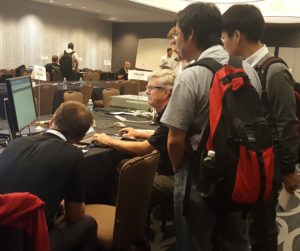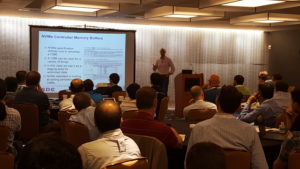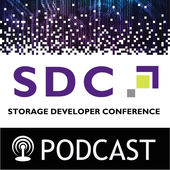For the next two weeks, SNIA on Storage will highlight exciting interest areas in the 2015 SNIA Storage Developer Conference (SDC) agenda. If you have not registered, you need to! Visit www.storagedeveloper.org to see the four day overview and sign up.
Cloud storage is hot, and whether you are new to the cloud or an experienced developer, SDC has a great lineup of speakers and sessions. Preview sessions here, and click on the title to find more details.
If you are just dipping your toes into cloud technology, you will want to check out the SDC Pre-Conference Primer on Sunday September 20. These sessions are included with full conference registration.
Here, SNIA Cloud Storage TWG Co-Chairs, David Slik and Mark Carlson, will explain all you Need to Know on Cloud Storage. You will come up to speed on the concepts, conventions, and standards in this space, and even see a live demo of an operating storage cloud. And Brian Mason, MTS-SW at NetApp, will review how to use REST API for Management Integration and how developers can use their best in class management tools and have various storage systems integrate into their management tools.
At the SDC Conference, the Cloud track kicks off with David Slik, SNIA Cloud Storage TWG Co-Chair and Technical Director at NetApp, discussing how to Use SNIA’s Cloud Data Management Interface (CDMI) to Manage Swift, S3, and Ceph Object Repositories, and how the use of CDMI as a management protocol adds value to multi-protocol systems.
Yong Chen, Assistant Professor at Texas Tech University will speak on Unistore: A Unified Storage Architecture for Cloud Computing. He will introduce an ongoing effort from Texas Tech University and Nimboxx Inc. to build an innovative unified storage architecture (Unistore) with the co-existence and efficient integration of heterogeneous HDD and SCM devices for Cloud storage.
Luke Behnke, VP of Products at Bitcasa will present The Developer’s Dilemma: Do-It-Yourself Storage or Surrender Your Data? He’ll discuss the choice between DIY or cloud storage APIs, and how this will impact future functionality and user experience.
Sachin Goswami, Solution Architect and Storage COE Head Hi Tech, Tata Consultancy Services ((TCS), will explain How to Test CDMI Extension Features Like LTFS, Data Deduplication, and OVF, Partial – Value Copy Functionality: Challenges, Solutions and Best Practices, sharing the approach TCS will adopt to overcome the challenges in testing of LTFS integration with CDMI, Data Deduplication, partial upload on Server and Open Vitalization format (OVF) of CDMI and Non-CDMI based scenarios of the cloud.
Speaking of the CDMI standard, join the Cloud Plugfest at SDC starting on September 21st to learn more about the CDMI Conformance Test Program and test your application for CDMI conformance.
And you won’t want to miss the Birds-Of-a-Feather (BOF) Sessions on Cloud! The first is on Tuesday evening, September 22, on Getting Started with the CDMI Conformance Test Program! Come to this OPEN TO ALL Birds of a Feather session to learn what the CTP program entails, details on the testing service that is offered, and how to get the CTP process started.
On Wednesday evening, September 23, the Moving Data Protection to the Cloud: Trends, Challenges and Strategies BOF will discuss critical cloud data protection challenges, how to use the cloud for data protection, pros and cons of various cloud data protection strategies, experiences of others (good and bad) to avoid common pitfalls, and cloud standards in use – and why you need them! This BOF is open to all!
Register now at www.storagedeveloper.org. And stay tuned for tomorrow’s blog on Management topics at SDC!

 c Storage, and SMB3 plugfests; ten Birds-of-a-Feather Sessions, and amazing networking among 450+ attendees. Sessions on NVMe over Fabrics won the title of most attended, but Persistent Memory, Object Storage, and Performance were right behind. Many thanks to SDC 2016 Sponsors, who engaged attendees in exciting technology discussions.
c Storage, and SMB3 plugfests; ten Birds-of-a-Feather Sessions, and amazing networking among 450+ attendees. Sessions on NVMe over Fabrics won the title of most attended, but Persistent Memory, Object Storage, and Performance were right behind. Many thanks to SDC 2016 Sponsors, who engaged attendees in exciting technology discussions. You’ll want to stream keynotes from Citigroup, Toshiba, DSSD, Los Alamos National Labs, Broadcom, Microsemi, and Intel – they’re available now on demand on SNIA’s YouTube channel,
You’ll want to stream keynotes from Citigroup, Toshiba, DSSD, Los Alamos National Labs, Broadcom, Microsemi, and Intel – they’re available now on demand on SNIA’s YouTube channel,  can get a “sound bite” of what to expect by downloading SDC podcasts via
can get a “sound bite” of what to expect by downloading SDC podcasts via 